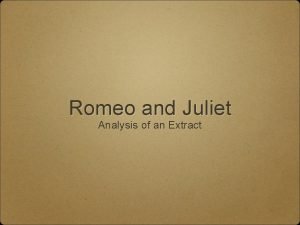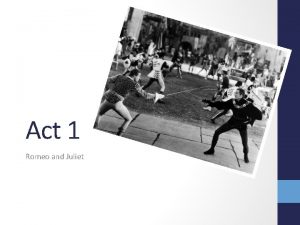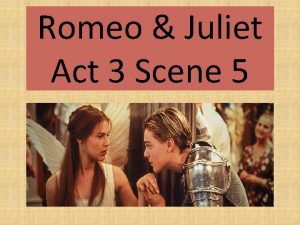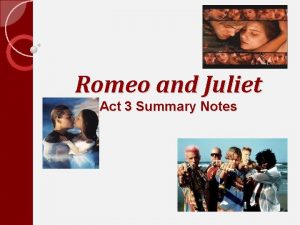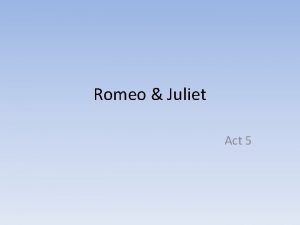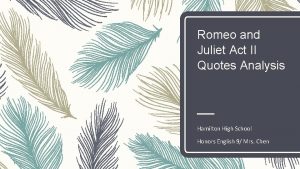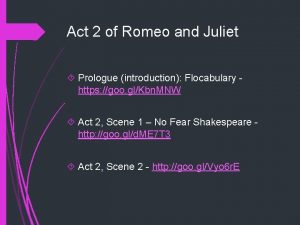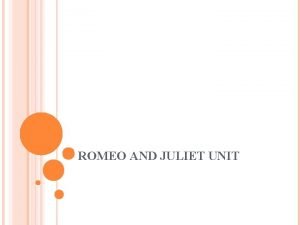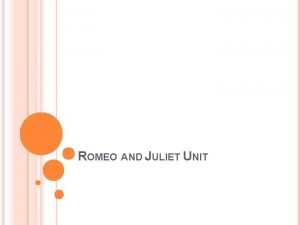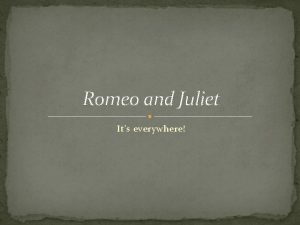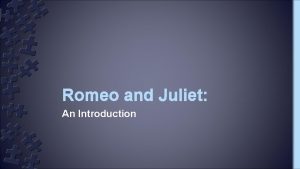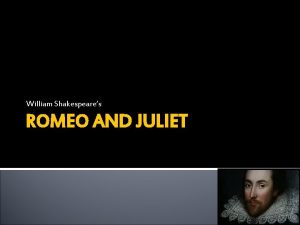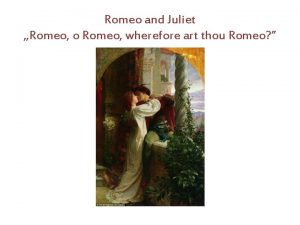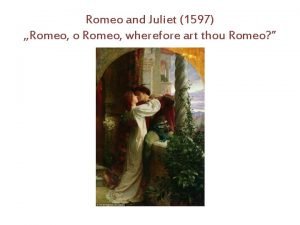Romeo and Juliet Analysis of an Extract ACT









- Slides: 9

Romeo and Juliet Analysis of an Extract

ACT III, SCENE III lines 29 - 53 Romeo. ‘ Tis torture, and not mercy: heaven is here, Where Juliet lives; and every cat and dog And little mouse, every unworthy thing, Live here in heaven and may look on her; Flies may do this, but I from this must fly: They are free men, but I am banished. And say'st thou yet that exile is not death? But Romeo may not: more validity, Hadst thou no poison mix'd, no sharp-ground knife, More honourable state, more courtship lives No sudden mean of death, though ne'er so mean, In carrion-flies than Romeo: they my seize But 'banished' to kill me? —'banished'? On the white wonder of dear Juliet's hand O friar, the damned use that word in hell; And steal immortal blessing from her lips, Howlings attend it: how hast thou the heart, Who even in pure and vestal modesty, Being a divine, a ghostly confessor, Still blush, as thinking their own kisses sin; But Romeo may not; he is banished: But 'banished' to kill me? —'banished'? A sin-absolver, and my friend profess'd, To mangle me with that word 'banished'?

Where the extract falls in the narrative arc This extract comes after the climactic scene of violence between Romeo and Tybalt. The ‘ancient grudge’ between the houses comes to a head in the duel and Tybalt is killed Romeo sees himself as ‘fortune’s fool’ and personifies theme of fate as being in charge of his destiny Act III, Scene III parallels the previous scene where Juliet learns her new ‘lord’, Romeo has slain her cousin Tybalt. Her behaviour juxtaposes that of Romeo’s because while she expresses strong emotion, she is not quite as dramatic is during this scene. By placing the scenes along side each other the audience is led to see the differences in maturity between the characters and Romeo’s tragic fatal flaw is emphasised. He is the embodiment of Friar Laurence’s warning - ‘Wisely and slow. They stumble that run fast’ Act II, Scene III.

Themes embedded within the scene This extract explores theme of ‘death’ - for Romeo "Then banishéd' / Is death, misterm'd. " In other parts of the play, Romeo confesses that he feels he has married death. The theme of fate is also relevant as Romeo sees the events as being part of his predicted destiny and the Friar concurs stating Romeo is “wedded to calamity. " The Friar's words echo Juliet's thoughts at the end of the previous scene when she says that Romeo's banishment will be a form of living death.

An analysis of how meaning has been constructed for the audience… Religious imagery

Animal imagery Shakespeare has referenced animals in this passage to compare Romeo and his entire situation in banishment as worse than any common dog, cat or mouse, because ‘they’ can still see her. Also Shakespeare talks of ‘carrion-flies’ having more worth than Romeo, to exaggerate the entire situation. Carrion flies are carnivorous flies that are often seen as pests or vermin, allowing for more drama and tension. Another example of Animal Imagery is the use of the word ‘howling’ which is often associated with wolves and is used to further the overall atmosphere of the extract. - Also the cats, dogs and mouse can symbolise conflict which relates to the 2 houses: Capulet and Montague.

Structure of the extract • • The pace within the piece varies as Romeo sulks about his banishment; as he thinks death would be better than banishment. Within the following line; “Howling attends it! How hast thou the heart” the ‘H’ slows the pace and elongates it to demonstrate how Romeo is moaning and sulking. The word ‘howling’ is onomatopoeic and gives a sense of trouble. ‘ing’ makes the event immediate and therefore when a word is ends with ‘ing’ such as “Still blush, as thinking their own kisses sin” in which the pace increases to demonstrate his distress in the immediate moment. Through the use of commas and full stops Shakespeare slows the pace once again. Rhetorical questions have also been used to illustrate Romeo’s internal struggle.

At the conclusion of the scene This scene is also driven by the conflict between the older and younger generations. The Friar chastises Romeo and reminds him of his good fortune that the Prince has commuted his sentence from death to a "gentler judgement" of exile. The Friar's contemplative work is far removed from the blind passion and emotional torment that Romeo is experiencing. Romeo, in his agitated state, is unable to accept the calm, philosophical reasoning the Friar offers. As in previous and subsequent scenes, the older generation's failure to comprehend the depth of Romeo and Juliet's passion isolates the lovers from sources of wisdom that might otherwise prevent their tragic fates.

The importance of this extract within the context of the play • • We see the aspect of impulsiveness develop in his character. The regret of his impulsive actions Its just after the climax, the start of the downhill, the beginning of the end. We see his fatal flaw further develop and the reasons for his downfall are negatively obviously shown. Romeo is shown as melodramatic, what happens at the beginning of the play with Romeo being sad over
 Romeo and juliet extract
Romeo and juliet extract Romeo and juliet script oh romeo i've missed you
Romeo and juliet script oh romeo i've missed you Paris asks lord capulet for permission to
Paris asks lord capulet for permission to Romeo and juliet act 3 scene 5 script
Romeo and juliet act 3 scene 5 script Romeo and juliet act 3 scene 1 summary
Romeo and juliet act 3 scene 1 summary Imagery in romeo and juliet act 5
Imagery in romeo and juliet act 5 Romeo and juliet act 1 quotes analysis
Romeo and juliet act 1 quotes analysis Romeo and juliet act iv continued
Romeo and juliet act iv continued Romeo and juliet act 2 prologue analysis
Romeo and juliet act 2 prologue analysis Romeo and juliet act 4 questions
Romeo and juliet act 4 questions
